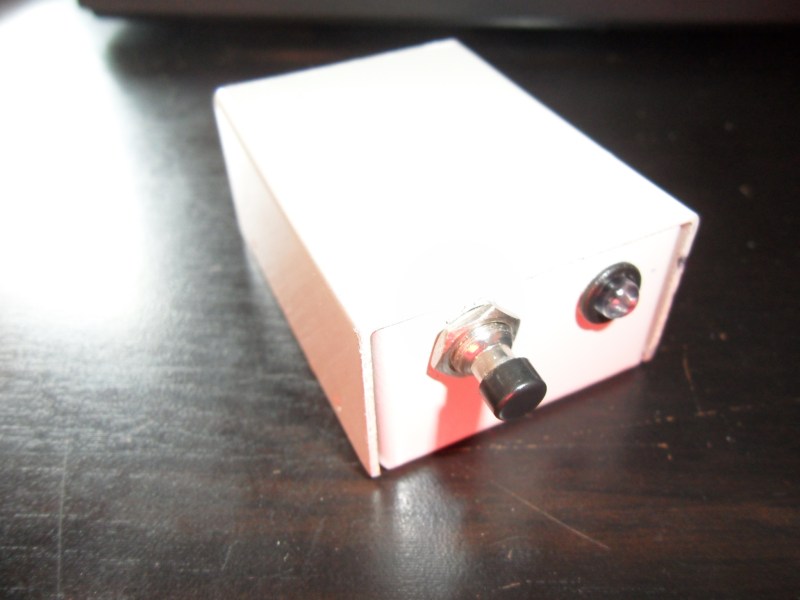[Glitchmaker] loves photography and wrote in to tell us about his newest project. He has a Canon 1000D camera but, unfortunately, it does not have time lapse capability. So, instead of shelling out a chunk of change for a new camera [Glitchmaker] decided to make an external shutter control device that can continue to instruct the camera to take photos at predetermined intervals. He calls his project: SHTTTRRR. You didn’t think that meant something else, did you?
You can see the unassuming box above, there is just enough stuff packed in there to get the job done, nothing extra or fancy. Luckily, the Cannon camera has a remote shutter input jack that only requires connecting one pin to another in order to take a photo. Inside the box is an ATTINY45 microcontroller. It reads the button pushes from the single panel-mounted button and calculates the time between two button presses. That time between button presses determines the frequency of the photos taken. At the appropriate times, the ATTINY45 signals a transistor to connect the two appropriate pins on the camera’s remote shutter input jack. The device continues to tell the camera to take photos until it is shut off. The result is a series of time-lapse photos that was previously not possible on that camera!
This is a simple project that solves a problem and gets the job done. What’s better than that? [Glitchmaker] is proud of the SHTTTRRR he made and also learned a bunch about programming the ATTINY45 along the way. Check a video of it working after the break.















This is probably some serious overkill. A simple triggertrap cable and a phone would do the same.
… i know its 2015… but a solution with a dependency on a smartphone doesn’t sound any less ‘overkill’ to me?
Ok, fine, but you could build this rig with an egg timer as well.. or an MP3 player.
The overkill is the Attiny45. He should replace it with an Attiny13, Same size, less power. :-)
555 ;-)
Or you could get this: http://www.bhphotovideo.com/c/product/840098-REG/Vello_rc_c2ii_Shutterboss_Version_II_Timer.html which does a whole lot more and actually has an interface. Programming the device above for an exposure every hour would be a bit tedious!
Canon makes one too but it’s a bit of a rip at $129
orrrr you could save your money for and build this with crap you have laying around.
Not to knock the device, it is as he said a way to experiment with the attiny, but out of curiosity doesn’t the camera has a delayed series option in its software? I thought hat was common.
I think you’re referring to the aftermarket firmware ‘CHDK’. This device has not been ported to use that firmware
There are still ways of using CHDK on Canon Cameras that aren’t supported
No I was actually expected it in the company’s software, I’ve seen it in modern cameras I think, as default. And why not, it’s a simple thing to incorporate and more useful than many of the ‘filter effects’ they seem to insist putting in even expensive cameras.
The 1000d is pretty old and there is no support for it under Magic Lantern.
anyone else read that title the way I did? a device that allows you to take your time in the toilet?
I was actually thinking the same thing. My first thought upon reading the title was “do i really need a device to let me take my time on the toilet? what kind of world do these guys live in?”
Hackaday needs a +1 button….
There’s definitely an “i” popping up in my head when I read the headline :-)
SHTTTRRR’s Full!
dang it… beat me to it. well played!
Nice! I don’t know if it’s possible with that chip, but I’d look at using that same button, and instead of using it as a sort-of tap-tempo function for purely repetitious shutter behavior, you might be able to cycle through a series of programmed behaviours. For example, control 4 separate shutter behaviours, including delay/timing, multiple exposures (burst), time-lapse/timing, etc. (even add a motion sensor or IR beam switch with presets for when beam breaks). Say there’s 4 behaviors: you’d press the button 1-4 times rapidly, then pause for a full second- now you’ve selected the behavior. Now repeatedly press to cycle through presets for the selected behavior (if time-lapse, then -rather than 2 button-presses with timing between directly correlating to shutter timing- each press would cycle through presets, such as: 5s, 10s, 15s, 30s, 1m, 2m, 5m, 10m, 15m, 30m, 1h, etc.).
yeah, or you could save yourself and your clients some aggravation and spend the $49. Not detracting from the hackycoolness, but the best hacks work BETTER than the stuff you can buy.
I disagree. The best hacks make a whole lot of noise and light everything around them on fire.
Different strokes. :V
Well, i concede that those hacks are not without their charm. But they don’t get written up on Hackaday, either. (unless your lucky enough to make the ‘fails’ column)